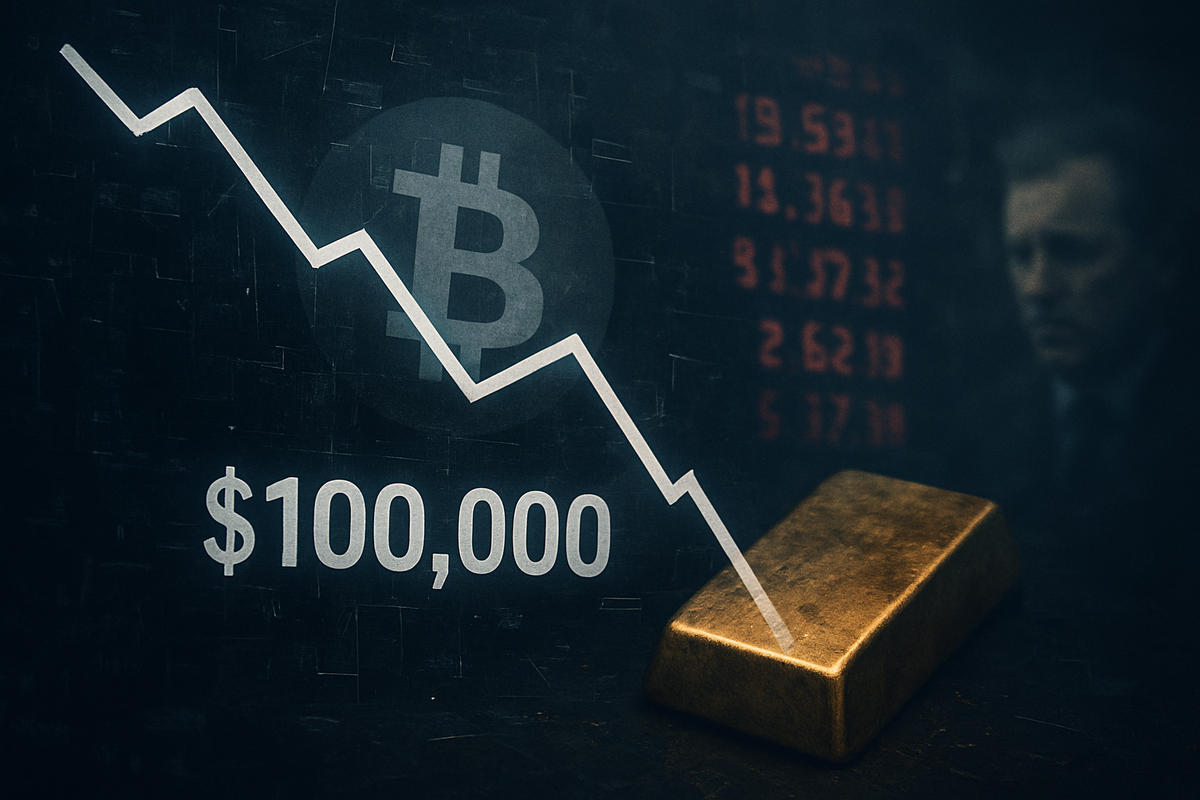
The global financial landscape is currently grappling with a significant downturn, characterized by a pervasive "risk-off" sentiment that has sent ripples across various asset classes. In a stark development, Bitcoin (BTC), the world's leading cryptocurrency, has dramatically fallen below the critical $100,000 threshold, signaling a profound shift in investor confidence towards riskier assets. This crypto market tremor is not isolated; traditional safe-haven asset gold, while exhibiting complex dynamics, has also seen its share of volatility, reflecting the widespread caution gripping investors.
This market contraction is a direct consequence of a confluence of macroeconomic pressures, including persistent inflation concerns, an uncertain trajectory for Federal Reserve interest rate policies, and lingering geopolitical tensions. The collective impact has led to a noticeable deleveraging across portfolios, with investors opting for perceived safety over speculative growth, thereby reshaping the immediate outlook for both digital and traditional assets.
Bitcoin's Tumultuous Descent and Market's Anxious Reaction
The cryptocurrency market has been in a pronounced bear phase, with Bitcoin's recent plunge below $100,000 marking a significant psychological and technical breakdown. After reaching an all-time high of over $126,300 in early October 2025, Bitcoin experienced a sharp decline, falling from $124,000 to $101,000 between October 6 and November 6. The week leading up to November 11 saw it dip below $100,000 twice, culminating in a further decline to below $97,000 on November 13, reaching its lowest point in over six months. As of November 14, 2025, Bitcoin was trading around $99,188, reflecting a 2.84% decline over 24 hours and plunging to intraday lows of $94,480.
This rapid descent has triggered widespread panic among traders, evidenced by the Bitcoin Fear and Greed Index plummeting to an "Extreme Fear" low. The market witnessed massive liquidations, with over $1.10 billion in crypto positions liquidated in 24 hours, predominantly affecting long positions. Analysts describe the current environment as a "full-blown battle between the bulls and the bears," with a firmly bearish market structure persisting. Several factors fueled this decline: an abrupt transfer of 12,000 BTC by a Satoshi-era whale, weakening spot Bitcoin ETF demand, significant selling by long-term holders (estimated 815,000 BTC in 30 days), and a massive $4.04 billion BTC options expiry with a "max pain" level of $105,000. Macroeconomic headwinds, including doubts about Fed rate cuts and global economic slowdown concerns, further intensified selling pressure, exacerbated by automated trading and high leverage in the crypto market.
In contrast, gold has largely acted as a traditional safe-haven asset during this period of uncertainty. On November 14, gold jumped 5%, trading near $4,190 per ounce, as investors moved to perceived safety. While gold saw some stabilization around $4,175 per ounce after an earlier decline, the prevailing market conditions, particularly the uncertainty surrounding US interest rates and geopolitical tensions, support its role as a hedge. Gold prices were up nearly 4% over the week leading to November 14, reflecting a renewed rotation into real assets and strong physical demand, with record trading volume in October. Experts suggest gold could climb further, potentially to $4,700, if political or financial market risks escalate.
Corporate Fortunes: Winners and Losers in a Volatile Market
The current market volatility creates a challenging but also potentially opportunistic environment for public companies with exposure to cryptocurrencies and gold.
Crypto Exchanges are among the most directly impacted by the downturn. Publicly traded exchanges such as Coinbase Global (NASDAQ: COIN), Gemini Space Station (NYSE: GEMI), and Bullish (NYSE: BLSH) are facing significant headwinds due to lower trading volumes and reduced transaction fees. The "Extreme Fear" sentiment and substantial outflows from Bitcoin spot ETFs directly diminish their revenue streams. Companies like Robinhood Markets (NASDAQ: HOOD) and Interactive Brokers (NASDAQ: IBKR), which offer crypto trading, have also seen their stock prices drop as investors retreat from risky assets. However, exchanges that have diversified into derivatives, custody services, or blockchain infrastructure may show more resilience. Companies providing essential services like crypto AML and compliance solutions, such as TRM Labs, could see increased demand as regulatory scrutiny intensifies.
Crypto Mining Companies are particularly vulnerable to Bitcoin's price fluctuations. Firms like Riot Platforms (NASDAQ: RIOT), Marathon Digital Holdings (NASDAQ: MARA), Bitfarms Ltd. (NASDAQ: BITF), Bitdeer Technologies Group (NASDAQ: BTDR), and Cipher Mining (NASDAQ: CIFR) have experienced substantial stock price declines. Their profitability is highly sensitive to Bitcoin's value and operational costs like energy. A drop in Bitcoin's price, coupled with rising energy prices and regulatory pressures, compresses profit margins. The decline in "hashprice" intensifies these pressures, potentially leading to consolidation or even bankruptcies for less robust firms. However, miners with strong balance sheets, diversified revenue streams (e.g., leveraging infrastructure for AI), and highly energy-efficient operations, such as Hut 8 (NASDAQ: HUT) and Cango (NYSE: CANG), are better positioned to weather the storm.
Gold Producers stand to benefit significantly from the overall bullish outlook for gold, despite short-term corrections. Companies like Agnico Eagle Mines (NYSE: AEM) and Newmont Corporation (NYSE: NEM) benefit from "operational gearing," where modest price increases lead to disproportionately higher profit margins due to relatively fixed production costs. While they may experience temporary dips due to profit-taking, their Q3 2025 profitability was strong, generating substantial free cash flow at average gold prices of $3,400-$3,500 per ounce. Producers with low-cost operations and extensive reserves are particularly well-positioned. Orla Mining (TSX: OLA) is also highlighted as a company set to benefit. The sector is seeing capital migration from major producers to developers and explorers, signaling health and future growth, with Bank of America naming gold miners as its number one investment theme for 2025.
Financial Institutions with exposure to these assets face a mixed bag. Those with direct, highly leveraged exposure to cryptocurrencies could incur significant losses during the downturn. However, many large traditional financial institutions like BlackRock (NYSE: BLK), Fidelity (NYSE: FNF), and Morgan Stanley (NYSE: MS) are increasing their crypto exposure through managed funds, ETFs, or derivatives, rather than volatile direct holdings. Those offering diversified services such as crypto custody or prime brokerage, or developing robust compliance frameworks, are likely to be more resilient. On the gold front, institutions that have advised clients to increase gold allocations or hold significant physical gold or gold-backed ETFs are likely to benefit from gold's projected long-term rally. This includes central banks, which are aggressively accumulating gold.
Wider Significance: A Shifting Paradigm in Global Finance
The current market conditions, characterized by Bitcoin's fall and gold's complex performance, signify more than just short-term volatility; they point to deeper shifts in broader industry trends, potential ripple effects, evolving regulatory landscapes, and draw parallels with historical precedents.
Broader Industry Trends: The cryptocurrency market is in a significant downturn, often termed a "crypto winter," with over $1 trillion wiped from its total market capitalization since early October. This decline is driven by institutional outflows, reduced liquidity, macroeconomic uncertainty, and deleveraging events. There's a noticeable shift towards utility-driven tokens over meme coins, indicating market maturation. Conversely, gold, while experiencing a pullback, remains underpinned by strong long-term bullish fundamentals. Gold's rally is influenced by policy shifts in China, monetary policy expectations from the Federal Reserve, and persistent geopolitical and fiscal risks. Historically, crypto and gold have shown minimal co-movement, but recent trends suggest an evolving relationship, with institutional investors increasingly considering Bitcoin as an alternative to gold for portfolio diversification, and both assets showing resilience during uncertainty.
Ripple Effects: The sharp slide in crypto prices has triggered massive derivatives liquidations, significantly impacting crypto exchanges and related businesses. Companies heavily invested in Bitcoin, like MicroStrategy Inc. (NASDAQ: MSTR), have seen their stock prices decline as their shares often act as a proxy for Bitcoin sentiment. This volatility creates a challenging environment for crypto service providers. Traditional financial institutions, while generally cautious, are exploring crypto, and regulatory clarity could lead to more involvement, though the current downturn might delay some initiatives. A sustained crypto downturn could also impact the profitability of mining operations, potentially leading to consolidation. In the gold industry, consolidation influenced by policy changes may affect demand for physical gold and related products.
Regulatory and Policy Implications: The market conditions are likely to accelerate regulatory efforts, especially in the cryptocurrency space. 2025 has seen a significant push for regulatory clarity in the U.S., moving away from "regulation by enforcement." The "Guiding and Establishing National Innovation for U.S. Stablecoins" (GENIUS) Act, signed in July 2025, established a federal framework for stablecoins, mandating 100% high-quality liquid asset backing. Regulators globally will intensify their focus on consumer protection, market integrity, and cybersecurity. Debates over whether cryptocurrencies are securities or commodities are ongoing, shaping future legislation. Global harmonization efforts, such as the EU's Markets in Crypto-assets (MiCA) regulation, aim to foster responsible growth while managing risks.
Historical Precedents: Both crypto and gold markets have experienced significant downturns. Bitcoin has undergone several "crypto winters," historically demonstrating resilience and recovery within 2-3 years after major crashes. The current downturn, while severe, is described by some as "the most relaxed bear market," suggesting underlying market maturity. Gold has also seen multiple crashes throughout history but has consistently recovered, often spectacularly, as investors eventually sought its safe-haven properties during prolonged financial uncertainty. The current situation, with gold in a consolidation phase after a rally, suggests different market dynamics influenced by specific policy changes.
What Comes Next: Navigating the Future of Digital and Traditional Stores of Value
The path forward for cryptocurrencies and gold is fraught with both challenges and opportunities, demanding strategic pivots and adaptations from investors and industry players alike.
For Cryptocurrencies, the short-term outlook (late 2025 - 2026) suggests continued volatility but with potential for a rebound if Bitcoin holds key support levels. Regulatory clarity, particularly with the GENIUS Act for stablecoins and the potential CLARITY Act for classifying Bitcoin as a commodity, is expected to drive further institutional adoption. Stablecoins are anticipated to become ubiquitous by 2026, integrating into traditional financial systems. In the long term (beyond 2026), Bitcoin is expected to transition from a speculative asset to a core financial infrastructure component, with sophisticated derivatives and better risk integration. The Decentralized Finance (DeFi) market is projected for significant growth, and asset tokenization is gaining regulatory traction globally. Price predictions for Bitcoin are bullish, with some analysts forecasting $200,000 by early 2026. Strategic adaptations include prioritizing regulatory compliance, enhancing risk management, diversifying portfolios, and exploring sophisticated products like yield-generating ETFs and DeFi protocols. Opportunities lie in institutional adoption, stablecoin utility, and DeFi growth, while challenges include persistent volatility, lingering regulatory uncertainties for truly decentralized systems, and macroeconomic headwinds.
For Gold, the short-term (late 2025 - 2026) indicates continued bullishness, though with potential for corrections. Gold prices have surged significantly in 2025, driven by geopolitical tensions, recession probabilities, a weaker US dollar, lower US interest rates (Fed cut rates twice in 2025), and strong central bank demand. JPMorgan Research expects gold to average $3,675/oz by Q4 2025, rising towards $4,000/oz by Q2 2026, with more aggressive scenarios targeting $4,400-$4,700. Central banks, especially in emerging markets, are expected to continue their strong gold accumulation. Long-term (beyond 2026) projections see gold prices between $4,400 and $5,300 per ounce, maintaining its safe-haven status amidst geopolitical turmoil and persistent inflation risks. Strategic adaptations for investors include diversifying gold investments (bars, coins, ETFs), using gold as a hedge against inflation and uncertainty, and closely monitoring central bank policies and geopolitical events. Opportunities abound in geopolitical instability, central bank accumulation, and inflation concerns, while challenges include potential demand destruction from high prices, market overbought conditions, and policy shifts in major economies like China.
Comprehensive Wrap-Up: A New Era for Financial Assets
The current market environment underscores a pivotal moment for both cryptocurrencies and gold. While influenced by similar macroeconomic and geopolitical forces, their responses and roles in investor portfolios are diverging yet increasingly interconnected. Gold has firmly reasserted its traditional safe-haven status, experiencing a robust bull run fueled by central bank demand and global instability. Cryptocurrencies, despite their inherent volatility, are undergoing a significant maturation, characterized by increasing institutional adoption and a rapidly evolving regulatory landscape.
The year 2025 stands out as a landmark for crypto regulation, with frameworks for stablecoins and potential classifications for major cryptocurrencies laying the groundwork for broader integration into traditional finance. This regulatory clarity is a critical step towards realizing crypto's potential as a more stable and integrated asset class. Concurrently, gold's enduring appeal as a hedge against geopolitical risks, inflation, and currency devaluation is being reinforced by sustained central bank purchases and ongoing global uncertainties. Bitcoin, in particular, is moving beyond its purely speculative origins to become a foundational component of financial infrastructure, challenging its traditional "four-year cycle" narrative.
Looking ahead, the long-term outlook for both markets appears robust, though their trajectories will differ. Gold is in a structural bull market, supported by fundamental shifts in global reserve management and persistent systemic risks. The crypto market, while still prone to sharp pullbacks, is poised for more stable and integrated growth as institutional engagement deepens and regulatory clarity improves. The interplay between these two distinct yet influential asset classes—one a digital disruptor and the other a venerable commodity—will define financial markets for years to come, offering investors diverse options for hedging and capital appreciation.
Investors should closely monitor several key indicators in the coming months: central bank monetary policy decisions, especially from the US Federal Reserve, as they will profoundly impact both asset classes; ongoing regulatory developments in both the EU and US; geopolitical events that could drive safe-haven demand; institutional inflows into crypto ETFs; overall market liquidity; inflation data; and the performance of the US dollar. These factors will be critical in navigating the evolving landscape and making informed investment decisions in this new era of financial markets.
This content is intended for informational purposes only and is not financial advice






